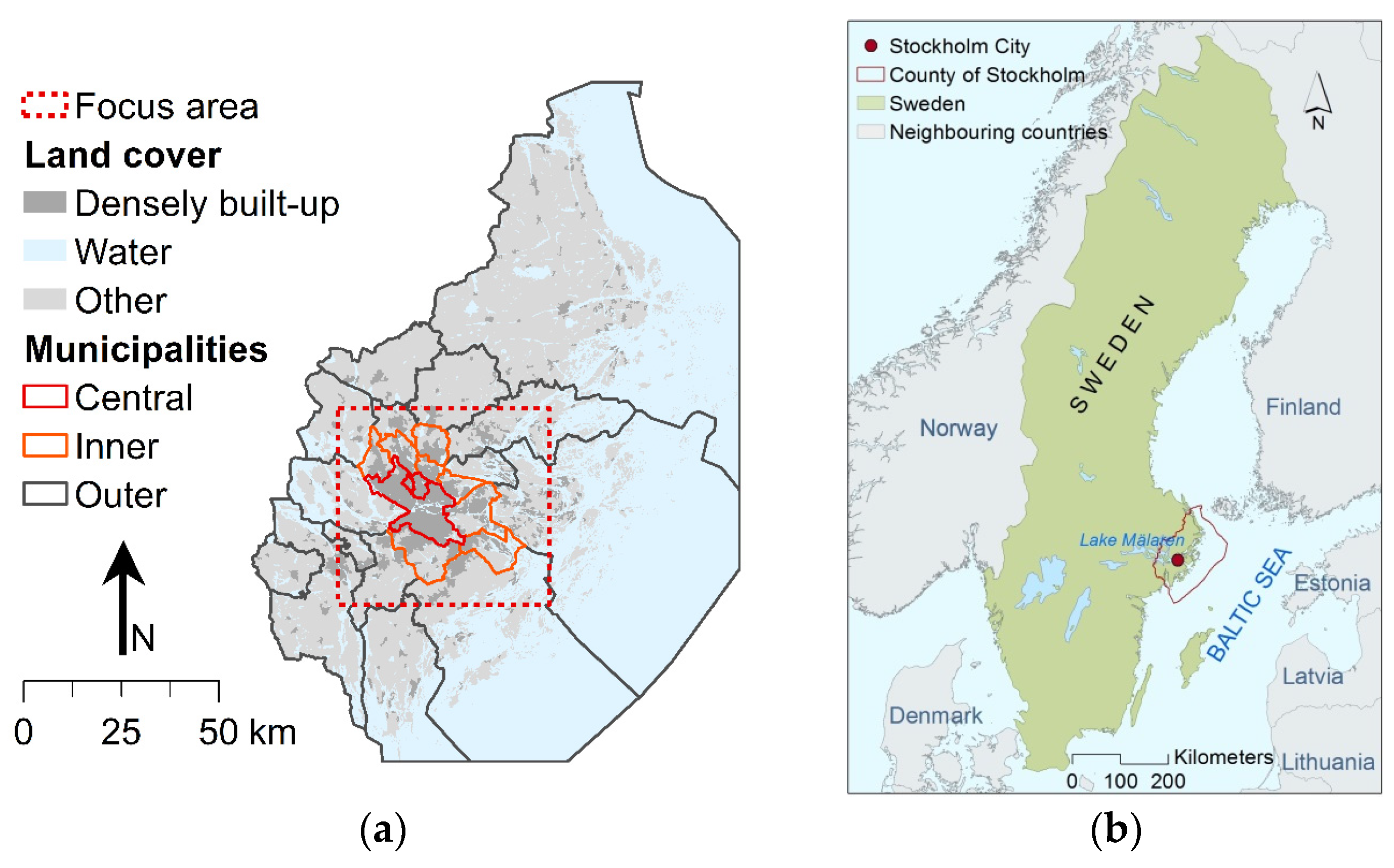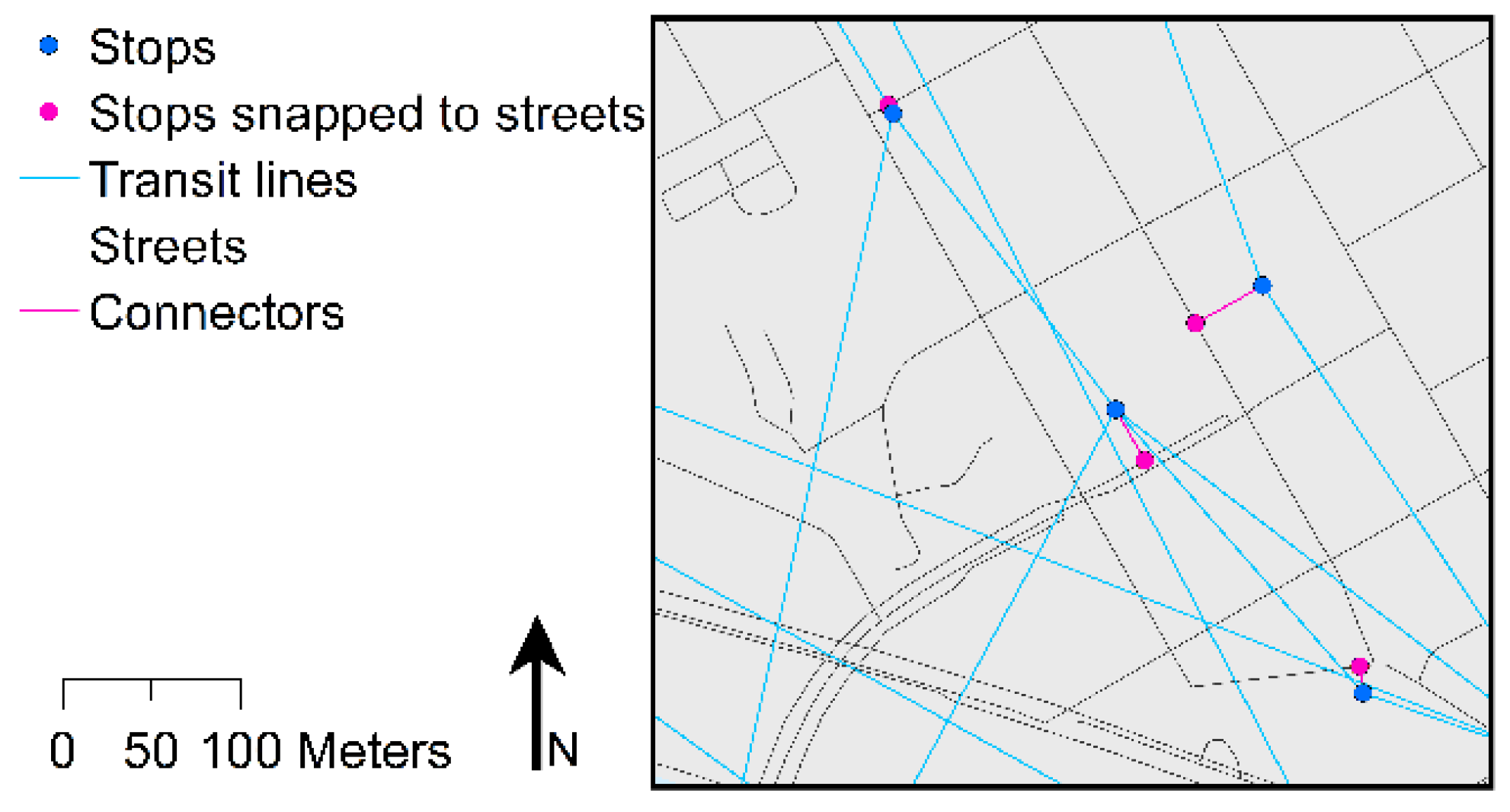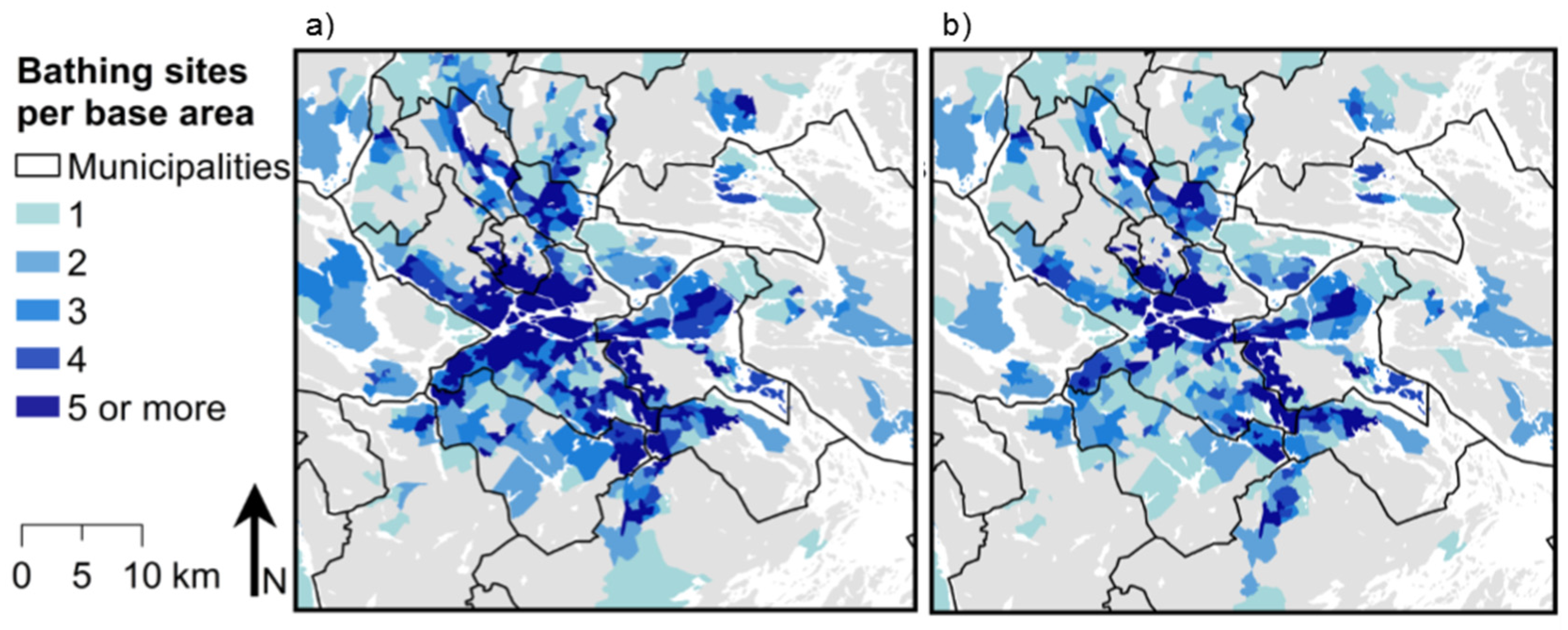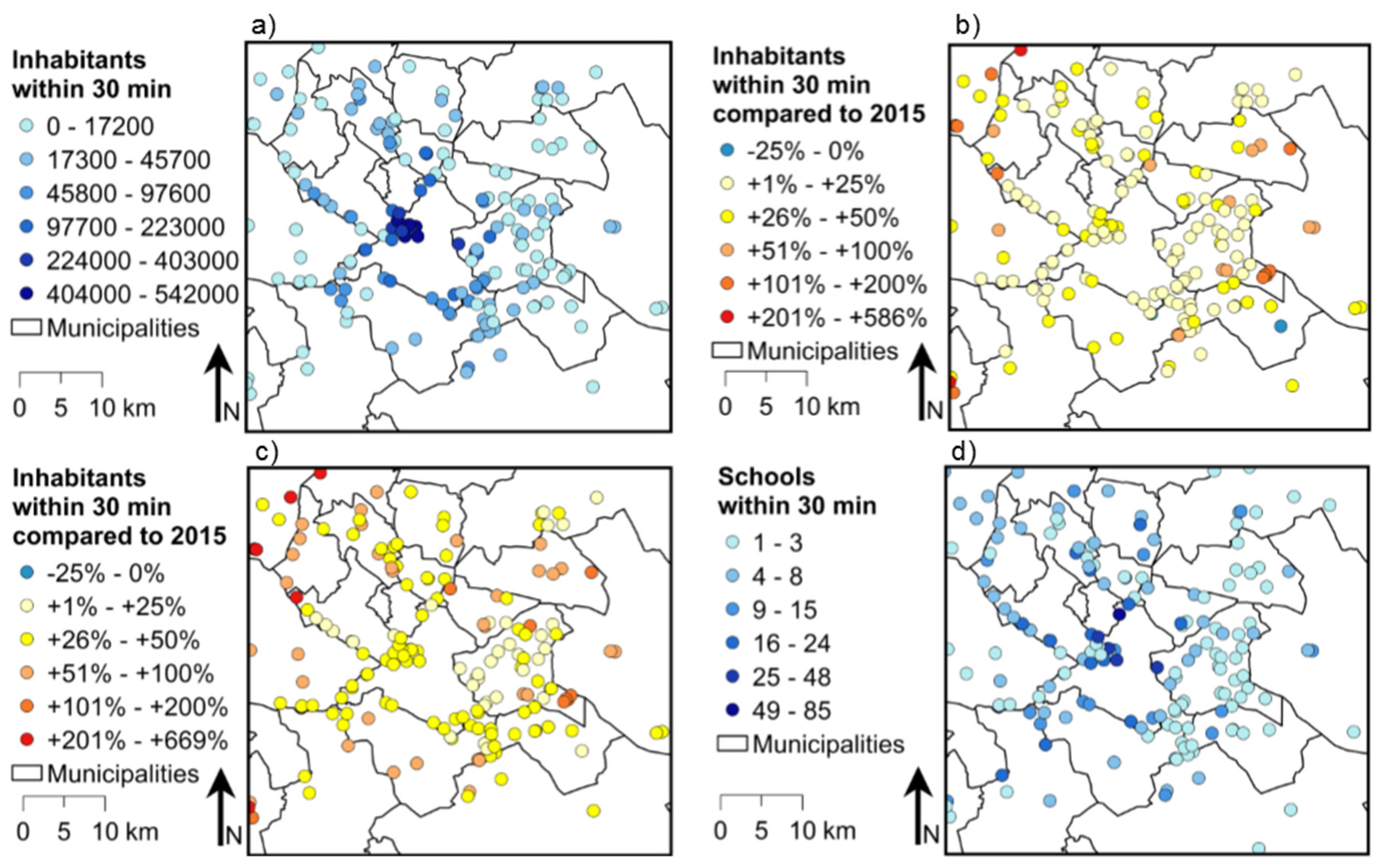Accessibility of Water-Related Cultural Ecosystem Services through Public Transport—A Model for Planning Support in the Stockholm Region
Abstract
:1. Introduction
2. Materials and Methods
2.1. Study Area
2.2. Focus Group Workshop
2.3. Data
2.4. Creation of a Network Model
- Public transport network includes transits operated by SL in April 2016.
- People can access the network via streets and public transport stops.
- Public transport transit lines can only be accessed via stops.
- Origins (e.g., base areas centroids) and destinations (e.g., bathing sites) are reachable via the network if they are located within 500 m of a street or a public transport stop.
- The travel time to a specific destination is uniform within a base area.
- It is possible to walk between public transport stops via the street network.
- The walk speed along the street network is 70 m/min.
- Travel times along public transport transits correspond to time tables.
2.5. Accessibility Calculations
3. Results
4. Discussion
4.1. Accessiblity to WCES
4.2. Model Properties and Development Potential
4.3. The GIS-Based Accessibility Model as Planning Support
5. Conclusions
Supplementary Materials
Acknowledgments
Author Contributions
Conflicts of Interest
References
- United Nations. World Urbanization Prospects—The 2014 Revision; ST/ESA/SER.A/366; United Nations, Department of Economic and Social Affairs; Population Division: New York, NY, USA, 2015. [Google Scholar]
- Elmqvist, T.; Redman, S.; Barthel, S.; Costanza, R. History of urbanization and the missing ecology. In Urbanization, biodiversity and ecosystem services: Challenges and opportunities. In A Global Assessment; Elmqvist, T., Fragkias, M., Goodness, J., Güneralp, B., Marcotullio, P.J., McDonald, R.I., Parnell, S., Schewenius, M., Sendstad, M., Seto, K.C., et al., Eds.; Springer: Dordrecht, The Netherlands, 2013. [Google Scholar]
- Niemelä, J.; Breuste, J.H.; Guntenspergen, G.; McIntyre, N.E.; Elmqvist, T.; James, P. Urban Ecology: Patterns, Processes, and Applications; Oxford University Press: Oxford, UK, 2011. [Google Scholar]
- Tzoulas, K.; Korpela, K.; Venn, S.; Yli-Pelkonen, V.; Kaźmierczak, A.; Niemela, J.; James, P. Promoting ecosystem and human health in urban areas using green infrastructure: A literature review. Landsc. Urban Plan. 2007, 81, 167–178. [Google Scholar] [CrossRef]
- Bolund, P.; Hunhammar, S. Ecosystem services in urban areas. Ecol. Econ. 1999, 29, 293–301. [Google Scholar] [CrossRef]
- Gómez-Baggethun, E.; Barton, D.N. Classifying and valuing ecosystem services for urban planning. Ecol. Econ. 2013, 86, 235–245. [Google Scholar] [CrossRef]
- Sallis, J.F.; Floyd, M.F.; Rodriguez, D.; Saelens, B.E. Role of built environments in physical activity, obesity, and cardiovascular disease. Circulation 2012, 125, 729–737. [Google Scholar] [CrossRef] [PubMed]
- Evenson, K.R.; Wen, F.; Hillier, A.; Cohen, D.A. Assessing the contribution of parks to physical activity using gps and accelerometry. Med. Sci. Sports Exerc. 2013, 45, 1981–1987. [Google Scholar] [CrossRef] [PubMed]
- Wolch, J.R.; Byrne, J.; Newell, J.P. Urban green space, public health, and environmental justice: The challenge of making cities ‘just green enough’. Landsc. Urban Plan. 2014, 125, 234–244. [Google Scholar] [CrossRef]
- Milcu, A.I.; Hanspach, J.; Abson, D.; Fischer, J. Cultural ecosystem services: A literature review and prospects for future research. Ecol. Soc. 2013, 18, 44. [Google Scholar] [CrossRef]
- Organisation for Economic Cooperation and Development. The Compact City Concept in Today’s Urban Contexts; OECD Publishing: Paris, France, 2012; p. 284. [Google Scholar]
- World Bank. Planning Energy Efficient and Livable Cities—Energy Efficient Cities; Knowledge Series 022/14, Mayoral Guidance Note #6; Energy Sector Management Assistance Program (ESMAP); World Bank: Washington, DC, USA, 2014. [Google Scholar]
- Grimm, N.B.; Faeth, S.H.; Golubiewski, N.E.; Redman, C.L.; Wu, J.G.; Bai, X.M.; Briggs, J.M. Global change and the ecology of cities. Science 2008, 319, 756–760. [Google Scholar] [CrossRef] [PubMed]
- Cities Alliance. Liveable Cities: The Benefits of Urban Environmental Planning; The Cities Alliance: Washington DC, USA, 2007. [Google Scholar]
- European Environmental Agency. Ensuring Quality of Life in Europe’s Cities and Towns—Tackling the Environmental Challenges Driven by European and Global Change; EEA Report No 5/2009; European Environment Agency: Copenhagen, Denmark, 2009. [Google Scholar]
- Goldenberg, R.; Kalantari, Z.; Cvetkovic, V.; Mörtberg, U.; Deal, B.; Destouni, G. Distinction, quantification and mapping of potential and realized demand and supply of ecosystem services. Sci. Total Environ. 2017. in review. [Google Scholar]
- Paracchini, M.L.; Zulian, G.; Kopperoinen, L.; Maes, J.; Schägner, J.P.; Termansen, M.; Zandersen, M.; Perez-Soba, M.; Scholefield, P.A.; Bidoglio, G. Mapping cultural ecosystem services: A framework to assess the potential for outdoor recreation across the EU. Ecol. Indic. 2014, 45, 371–385. [Google Scholar] [CrossRef]
- Ala-Hulkko, T.; Kotavaara, O.; Alahuhta, J.; Helle, P.; Hjort, J. Introducing accessibility analysis in mapping cultural ecosystem services. Ecol. Indic. 2016, 66, 416–427. [Google Scholar] [CrossRef]
- Fisher, B.; Turner, R.K.; Morling, P. Defining and classifying ecosystem services for decision making. Ecol. Econ. 2009, 68, 643–653. [Google Scholar] [CrossRef]
- Syrbe, R.-U.; Walz, U. Spatial indicators for the assessment of ecosystem services: Providing, benefiting and connecting areas and landscape metrics. Ecol. Indic. 2012, 21, 80–88. [Google Scholar] [CrossRef]
- Costanza, R. Ecosystem services: Multiple classification systems are needed. Biol. Conserv. 2008, 141, 350–352. [Google Scholar] [CrossRef]
- Mörtberg, U.; Goldenberg, R.; Kalantari, Z.; Kordas, O.; Deal, B.; Balfors, B.; Cvekovic, V. Integrating ecosystem services in the assessment of urban energy trajectories—A study of the Stockholm region. Energy Policy 2017, 100, 338–349. [Google Scholar] [CrossRef]
- Brabyn, L.; Sutton, S. A population based assessment of the geographical accessibility of outdoor recreation opportunities in New Zealand. Appl. Geogr. 2013, 41, 124–131. [Google Scholar] [CrossRef]
- Djurhuus, S.; Hansen, H.S.; Aadahl, M.; Glümer, C. Building a multimodal network and determining individual accessibility by public transportation. Environ. Plan. B Plan. Des. 2016, 43, 210–227. [Google Scholar] [CrossRef]
- Salonen, M.; Toivonen, T. Modelling travel time in urban networks: Comparable measures for private car and public transport. J. Transp. Geogr. 2013, 31, 143–153. [Google Scholar] [CrossRef]
- Hunt, J.D.; Simmonds, D.C. Theory and application of an integrated land-use and transport modeling framework. Environ. Plan. B Plan. Des. 1992, 20, 221–244. [Google Scholar] [CrossRef]
- Lefevre, B. Long-term energy consumptions of urban transportation: A prospective simulation of “transport–land uses” policies in Bangalore. Energy Policy 2009, 37, 940–953. [Google Scholar] [CrossRef]
- Waddell, P.; Ulfarsson, G.F.; Franklin, J.P.; Lobb, J. Incorporating land use in metropolitan transportation planning. Transp. Res. Part A Policy Pract. 2007, 41, 382–410. [Google Scholar] [CrossRef]
- Deal, B.; Pallathucheril, V. Simulating regional futures: The land-use evolution and impact assessment model (LEAM). In Planning Support Systems for Cities and Regions; Braill, R., Ed.; Lincoln Institute of Land Policy: Cambridge, MA, USA, 2008; pp. 61–84. [Google Scholar]
- Geertman, S.; Stillwell, J. Planning support systems: An inventory of current practice. Comput. Environ. Urban Syst. 2004, 28, 291–310. [Google Scholar] [CrossRef]
- Uran, O.; Janssen, R. Why are spatial decision support systems not used? Some experiences from The Netherlands. Comput. Environ. Urban Syst. 2003, 27, 511–526. [Google Scholar] [CrossRef]
- Brömmelstroet, M. Performance of Planning Support Systems: What is it, and how do we report it? Comput. Environ. Urban Syst. 2013, 41, 299–308. [Google Scholar] [CrossRef]
- Pelzer, P.; Geertman, S.; Heijden, R.; Rouwette, E. The added value of Planning Support Systems: A practitioner’s perspective. Comput. Environ. Urban Syst. 2014, 48, 16–27. [Google Scholar] [CrossRef]
- Statistics Sweden. Population Statistics; Statistics Sweden: Stockholm, Sweden, 2016; Available online: www.scb.se (accessed on 10 June 2016).
- Growth and Regional Planning Administration. Stärkt Hållbarhet i Europas Mest Attraktiva Storstadsregion—Program för ny Regional Utvecklingsplan för Stockholmsregionen, RUFS 2050; Growth and Regional Planning Administration: Stockholm, Sweden, 2015.
- Growth and Regional Planning Administration. Områdesdatabasen; Growth and Regional Planning Administration: Stockholm, Sweden, 2016. Available online: www.rufs.se/kartor/rufs-2010/befolkning-och-sysselsatta/ (accessed on 10 June 2016). (In Swedish)
- Growth and Regional Planning Administration. Befolkning, Sysselsättning och Inkomster i Östra Mellansverige—Reviderade Framskrivningar Till år 2050; Growth and Regional Planning Administration: Stockholm, Sweden, 2012. (In Swedish)
- Office of Regional Planning. Förslag Till Regional Utvecklingsplan för Stockholmsregionen—RUFS 2010. Så Blir vi Europas Mest Attraktiva Storstadsregion; Office of Regional Planning: Stockholm, Sweden, 2010. (In Swedish)
- Growth and Regional Planning Administration. Regional Miljöstrategi för Vatten; Growth and Regional Planning Administration; Stockholm County Council: Stockholm, Sweden, 2013. (In Swedish)
- Swedish National Agency for Education. Skolenheter på Karta; Swedish National Agency for Education: Stockholm, Sweden, 2016. Available online: www.skolverket.se/skolformer/skoladresser/skolenheter-pa-karta-1.214055 (accessed on 10 June 2016). (In Swedish)
- Storstockholms Lokaltrafik. Trafiklab; Storstockholms Lokaltrafik: Stockholm, Sweden, 2016; Available online: www.trafiklab.se/ (accessed on 10 June 2016).
- Swedish Transport Agency. Väg- och Järnvägsdata; Swedish Transport Agency: Borlänge, Sweden, 2016; Available online: www.trafikverket.se/tjanster/data/vag--och-jarnvagsdata/ (accessed on 10 June 2016). (In Swedish)
- Swedish Agency for Marine and Water Management. Badplatsen—Badplatser och Badvattnets Kvalitet; Swedish Agency for Marine and Water Management: Göteborg, Sweden, 2016; Available online: www.havochvatten.se/hav/fiske--fritid/badvatten.html (accessed on 10 June 2016). (In Swedish)
- Lantmäteriet. GSD Overview Map; Lantmäteriet: Gävle, Sweden, 2016. [Google Scholar]
- Environmental Systems Research Institute. ArcGIS Desktop, 10; Environmental Systems Research Institute: Redlands, CA, USA, 2014. [Google Scholar]
- Morang, M.; Stevens, P. Add GTFS to a Network Dataset in ArcGIS Desktop; Environmental Systems Research Institute: Redlands, CA, USA, 2016. [Google Scholar]
- Lüdtke, N.; Panzeri, S.; Brown, M.; Broomhead, D.S.; Knowles, J.; Montemurro, M.A.; Kell, D.B. Information-theoretic sensitivity analysis: A general method for credit assignment in complex networks. J. R. Soc. Interface 2008, 5, 223–235. [Google Scholar] [CrossRef] [PubMed]
- Convertino, M.; Muñoz-Carpena, R.; Chu-Agor, M.L.; Kiker, G.A.; Linkov, I. Untangling drivers of species distributions: Global sensitivity and uncertainty analyses of MaxEnt. Environ. Model. Softw. 2014, 51, 296–309. [Google Scholar] [CrossRef]
- Dawson, L.; Persson, K.; Balfors, B.; Mörtberg, U.; Jarsjö, J. Collaborative learning for water sustainability: Knowledge generation and use in a Swedish catchment. Land Use Policy 2017. in review. [Google Scholar]
- Bagstad, K.J.; Johnson, G.W.; Voigt, B.; Villa, F. Spatial dynamics of ecosystem service flows: A comprehensive approach to quantifying actual services. Ecosyst. Serv. 2013, 4, 117–125. [Google Scholar] [CrossRef]
- Mörtberg, U.; Haas, J.; Zetterberg, A.; Franklin, J.; Jonsson, D.; Deal, B. Urban ecosystems and sustainable urban development: Analysing and assessing interacting systems in the Stockholm region. Urban Ecosyst. 2013, 16, 763–782. [Google Scholar] [CrossRef]






| Data | Description | Source |
|---|---|---|
| Base areas | Polygon shapefile with census units | [36] |
| Census data | Population size per base area | [36] |
| Population forecasts | Predicted population size in 2050 per base area | [37] |
| Elementary schools | Point location of all elementary schools in the region 2014 | [40] |
| Public transport network | GTFS data including spatial information and time tables for public transport operated by SL | [41] |
| Street network | Line shapefile containing streets for cars, cycles and pedestrians | [42] |
| Bathing sites | Point location of water quality monitored bathing sites | [43] |
| Bathing sites | Point location of bathing sites managed by the municipality | 16 municipalities |
| Archipelago boat departure points | GTFS data including location of stops operated by the public archipelago boat agency Waxholmsbolaget | [41] |
| Map background elements | Land cover and municipality borders in vector format from the GSD overview map | [44] |
| Network Component | Group 1 | Group 2 | Group 3 |
|---|---|---|---|
| Public transport transit lines | X | ||
| Streets | X | ||
| Connectors between public transport stops and streets | X | ||
| Public transport stops | X | X | |
| Public transport stops snapped to closest street | X | X |
| Matrix Alias | Origins | Destinations | Time | Situation |
|---|---|---|---|---|
| A | Base area centroids | Bathing sites within 30 min travel time of each origin | Thursday 18:00 | Going swimming after a 9–5 work day |
| B | Base area centroids | The bathing site within the shortest travel time of each origin | Thursday 18:00 | Going swimming after a 9–5 work day |
| C | Base area centroids | Bathing sites within 30 min travel time of each origin | Sunday 12:00 | Going swimming in the weekend |
| D | Base area centroids | The bathing site within the shortest travel time of each origin | Sunday 12:00 | Going swimming in the weekend |
| E | Base area centroids | The public archipelago boat stop within the shortest travel time of each origin | Sunday 12:00 | Going on an archipelago trip in the weekend |
| F | Schools | Bathing sites within 30 min travel time of each origin | Thursday 14:00 | Going swimming after school with the youth leisure centre |
| 2015 | 2050 Baseline Scenario | 2050 High Net Immigration Scenario | |
|---|---|---|---|
| Public archipelago boat departure point | 35% | 34% | 33% |
| Bathing site Thursday 18:00 | 73% | 71% | 69% |
| Bathing site Sunday 12:00 | 67% | 64% | 63% |
© 2017 by the authors. Licensee MDPI, Basel, Switzerland. This article is an open access article distributed under the terms and conditions of the Creative Commons Attribution (CC BY) license ( http://creativecommons.org/licenses/by/4.0/).
Share and Cite
Kalantari, Z.; Khoshkar, S.; Falk, H.; Cvetkovic, V.; Mörtberg, U. Accessibility of Water-Related Cultural Ecosystem Services through Public Transport—A Model for Planning Support in the Stockholm Region. Sustainability 2017, 9, 346. https://doi.org/10.3390/su9030346
Kalantari Z, Khoshkar S, Falk H, Cvetkovic V, Mörtberg U. Accessibility of Water-Related Cultural Ecosystem Services through Public Transport—A Model for Planning Support in the Stockholm Region. Sustainability. 2017; 9(3):346. https://doi.org/10.3390/su9030346
Chicago/Turabian StyleKalantari, Zahra, Sara Khoshkar, Helena Falk, Vladimir Cvetkovic, and Ulla Mörtberg. 2017. "Accessibility of Water-Related Cultural Ecosystem Services through Public Transport—A Model for Planning Support in the Stockholm Region" Sustainability 9, no. 3: 346. https://doi.org/10.3390/su9030346
APA StyleKalantari, Z., Khoshkar, S., Falk, H., Cvetkovic, V., & Mörtberg, U. (2017). Accessibility of Water-Related Cultural Ecosystem Services through Public Transport—A Model for Planning Support in the Stockholm Region. Sustainability, 9(3), 346. https://doi.org/10.3390/su9030346







